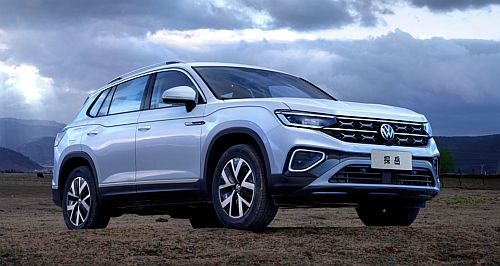News - VolkswagenVolkswagen pushes to offer more PHEVsMore PHEV models on the horizon for Volkswagen Australia, but not in time for FBT cut-off23 May 2024 VOLKSWAGEN Australia has only just launched its first plug-in hybrid EV (PHEV), but the brand says it is planning to expand its range of offerings in the electrified space across three other nameplates.
At the launch of the revised and repositioned Touareg range, the brand made clear its plans to offer PHEV versions of the Golf hatchback (expected when the Mark 8.5 facelift launches in the second quarter of next year), as well as the new-generation Tiguan mid-size SUV (due late 2024 or early 2025), and the all-new Tayron seven-seater SUV (late 2025).
The first PHEV for the business is the Touareg R e-Hybrid, the most powerful VW yet, not to mention the most fuel-efficient ever in Australia, and one of the most expensive, too. But the brand says it is mindful of buyers who can’t shell out $130K on a large SUV, and will cater to more budget-friendly price points for a selection
Ralph Beckmann, general manager of marketing and product for VW Australia passenger vehicles, said those models will help pull down the entry point for plug-in tech for the brand.
“It’s probably no surprise that it could be Golf and Tiguan, and then potentially another player who is coming into the family that we’re not going to be talking about today,” he said, referring to the first-ever Tayron.
“It’s an opportunity now to open these conversations again. I think there is definitely room for it in the market.
“We saw it in the ‘Register Your Interest’ numbers as well (for Touareg R)” he said, referring to the 2000 customer inquiries on the range-topping PHEV, which is a $129,990 plus on-road costs proposition.
“The plug-in hybrid seems to have an important role to play in the market as well. So, we’d love to offer it beyond the pure electric product in the other ranges, as well,” he said, referring to the imminent – yet delayed – launch of the VW ID electric vehicle range.
None of the aforementioned models, however, will make it in time to take advantage of the current deadline for the Fringe Benefits Tax (FBT) exemption offered for plug-in hybrid models, which expires on March 31, 2025.
That tax break is causing an unprecedented spike in demand for PHEV models, and furthering the discussion about what makes a PHEV work for an Aussie buyer.
Many critics have suggested that the EV-only driving range – often limited to 60km or less – is not enough to justify the extra expense, as many PHEVs attract a $10,000 to $20,000 premium over the existing ICE versions.
The argument is there that you’ll save that and more if you can get into a PHEV by the deadline, but Mr Beckmann said the brand won’t be able to slip any of those models in the market before the Electric Car Discount scheme for PHEVs expires.
“From a timing point of view, I don’t think so,” said Mr Beckmann.
“To be honest, you wouldn’t be bringing it in ‘on the fly’, it would make sense with a new model change.
“So, for the outgoing model Tiguan, we wouldn’t be able to get a PHEV anymore. So, it would be a potential addition for the Tiguan 3 (third generation) range,” he said, and that new-gen Tiguan isn’t due here until around March, 2024.
That Tiguan PHEV model is said to offer up to 120km of EV driving range, which should allay some of the concerns of longer commuters.
Daniel DeGasperi, product and PR communications manager, said VW Australia is in a better position now because of the New Vehicle Emissions Scheme being legislated, in that it essentially allows the brand to pick and choose from a larger pool of models than it previously was able to.
“There are a lot of calculations going on at the moment, and this is one of the benefits of being part of the Volkswagen Group – and this goes for Skoda and Cupra as well – is that we have access to such a diverse range of products,” he said.
“(We’re) moving out of quite a limited volume pool (of production for markets that don’t have an emissions scheme) of EV or PHEV products; the NVES unlocks potential extra production, not just for ID.4, but it moves us into a different conversation.
“That’s consistent with what Volkswagen has been saying for many years, we need an emissions regulation system to compel our factories to put as into that consideration set and that will hopefully unlock a lot of those production and product opportunities.”
Exact details on which models will be offered here, and the pricing premium expected, remains to be seen, but it is clear from the position of the Cupra brand that plug-in hybrids will sit higher up the range.
In that instance, the Cupra Leon VZe plug-in hybrid hatch lists at $61,690 – some $15,000 more than the base model Leon V petrol. It is worth noting, though, that it also sits adjacent to the performance-oriented VZx Leon, at the exact same price.
Likewise, the Formentor mid-size SUV has the VZe ($64,990) at a notable premium over the base grade, which kicks off at $51,990. The performance and technical spec is not the same, it must be said, but the additional asking price isn’t unsubstantial.  Read more |
Click to shareVolkswagen articlesResearch Volkswagen Motor industry news |

















Facebook Twitter Instagram